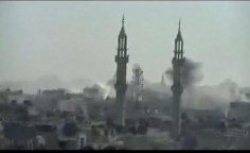The events in the New Clock Square on April 18, 2011, evoke both bitter and sweet memories for the thousands who participated in the largest demonstration in the city center since the country-wide uprising against President Bashar al-Assad had started.
"It was a day where we thought the Syrian regime was two days from collapsing. A day when all remaining barriers of fears were broken," Ammar, an employee at an internet cafe in Homs, said.
The sit-in in the New Clock Square began as a funeral for seven anti-government protesters killed by the regime forces a day earlier. Tens of thousands participated in the burial at al-Kateeb cemetery.
"On our way back from the cemetery, we started chanting ‘to the clock, to the clock’ and ‘sit-in, sit-in’. And when we passed by the Christian neighborhood of Hamidiyeh we started chanting “the Syrian people are one’."
"Our Christian brothers were throwing rice, rose petals and water drops from the balconies. It was beautiful," Aboudi, a 17-year-old student in Homs, said.
People began flocking into the square from all directions. Protesters from other neighborhoods entered the city center with no apparent resistance from security forces. Soon enough, the square was transformed into a carnival.
"We set up tents, we brought food, we listened to speeches, we chanted. It was like a dream come true," Aboudi said.
Because the square was surrounded by banks and companies equipped with surveillance cameras, activists quickly wrapped them in plastic bags to prevent security forces from using the footage to identify the demonstrators.
Some people suggested we break the cameras. But we decided it to use bags instead. This is how organized and civilized the Homs sit-in was," Ammar said.
'Shot in cold blood'
Majd, a 21-year-old Homs resident, said people were surprised the regime was allowing them to carry out the protest without interference.
"There were policemen watching us from a distance. That was it. But we were still very suspicious," he said.
"Religious leaders started asking us to leave. They also felt the regime was up to something."
And they were right.
The crowd was dispersed by security forces after midnight, at around 1:45am, with intense rounds of live bullets. Several people were killed.
Ammar said he believed the security forces first began shooting in the air. But later they shot at people as they ran away.
"People were running in all directions. Many of us hid in commercial buildings and slept there overnight. The sounds of bullets were unbelievable".
Majd said a man shouted ‘I want to curse the family of Assad’.
"They shot him. They shot him in cold blood," he said.
There is no verified death toll from the crackdown on the protest. A local activist group says tens were killed, but has only documented the names of eight.
The uprising against Assad had only started about a month earlier and there were no established activist networks which could effectively document deaths, Abou Rami, an activist in Homs, said.
"The regime made it so difficult for people to find out the fate of those who could not run away. They removed the bodies and the square was cleaned overnight from all the blood and glass pieces," he said.
"They cleaned it as if nothing had happened a day earlier."
'Angry city'
However, despite attempts to restore the business-as-usual mode, Ammar said Homs was forever changed.
"Homs became an angry city. While the upper class had not yet been very involved in demonstrations, the sit-in near their homes moved them. They became an integral part of the protest movement in the city," he said.
The brutal crackdown on the sit-in, Ammar said, was meant to deter activists from attempting to occupy the city centers of the capital, Damascus, and Aleppo, the country’s second city Aleppo.
"I think that Assad saw the new trend of sit-ins and wanted to stop it. Before the Homs protest, there had been a large rally in [the coastal city of] Latakia and another one in [the Damascus suburb of] Douma, but they were not comparable in numbers to the New Clock Square sit-in.
"Assad wanted to teach a lesson to all Syrians through Homs."
One year on, many Homs neighborhoods are unrecognizable. Activists say hundreds have been killed in the city.
Since the sit-in, residents of Homs have tried on several occasions to recreate the city center rally by calling on people to "crawl to the New Clock Square", but the heavy security around the area and the presence of snipers on the rooftops around the square have made it impossible.
However, Abu Rami and many others who participated remain defiant and hopeful that they will return to what they now call "Freedom Square".
"For us in Homs, the regime has fallen," he said. "Re-occupying the square is only a technicality. I see this day coming soon."
PHOTO CAPTION
Forces loyal to Syrian President Bashar al-Assad shell the opposition stronghold of Homs, two days after U.N. truce monitors arrived in Damascus.
Al-Jazeera


 Home
Home Discover Islam
Discover Islam Quran Recitations
Quran Recitations Lectures
Lectures
 Fatwa
Fatwa Articles
Articles Fiqh
Fiqh E-Books
E-Books Boys & Girls
Boys & Girls  Ramadan
Ramadan Fatwa Audios
Fatwa Audios Month of Mercy
Month of Mercy Women
Women Eed Al- Fitr
Eed Al- Fitr Food Recipes
Food Recipes Videos
Videos

 Prayer Times
Prayer Times












